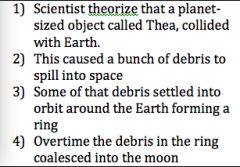![]()
![]()
![]()
Use LEFT and RIGHT arrow keys to navigate between flashcards;
Use UP and DOWN arrow keys to flip the card;
H to show hint;
A reads text to speech;
39 Cards in this Set
- Front
- Back
|
Phases: |
The different “shapes” of the moon as it completes a revolution around the Earth caused by changes in the position of the Earth and Moon |
|
|
Eclipse |
When an object in space comes between the sun and a third object, it casts a shadow on the third object causing an eclipse |
|
|
Umbra |
The darkest part of an objects shadow. From any point in the umbra, light is blocked out |
|
|
Penumbra |
The largest part of an objects shadow. From any point in the penumbra, some light is visible and some is blocked out |
|
|
Lunar Eclipse |
When the Earth passes directly between the moon and the sun, blocking sunlight from the moon |
|
|
Solar Eclipse |
When the moon passes directly between Earth and the sun, blocking sunlight from reaching the Earth |
|
|
Astronomy |

|
|
|
Rotation |

|
|
|
Axis |

|
|
|
Revolution |

|
|
|
What are the seasons caused by? |

|
|
|
Solstice |

|
|
|
Equinox |

|
|
|
Moons Characteristics |
size, Density, Temperature, Atmosphere, Water |
|
|
Origin of moon |

|
|
|
Maria |
Dark, flat areas |
|
|
Craters |

|
|
|
Highlands |

|
|
|
Tides |
Rise and fall of ocean water |
|
|
When do tides occur? |

|
|
|
Spring Tides |

|
|
|
When do Spring Tides occur |
Full and New moons |
|
|
Neap Tides |

|
|
|
When do neap tides occur |
Third and First quarter |
|
|
Do we always see the same side of the moon |
Yes |
|
|
Orbit |
Path Earth follows |
|

|
1. New moon 2. wanning gibbous 3. Third quarter 4. Wanning crescent 5. Full 6. Waxing crescent 7. 1st quarter 8. Waxing gibbous |
|
|
Which side of the moon appears in the waxing phase and first |
left |
|
|
Which side of the moon appears in the waning phase and 3rd quarter |
right |
|
|
In Earth days, how long is a day on the moon |
29.5 |
|
|
Compared to the Earth, how long is a year on the moon? |
1 day |
|
|
How long does it take the Earth to revolve once around the sun |
365.25 |
|
|
How long does it take the Earth to rotate once on its axis |
24 hrs |
|
|
What causes the phases of the moon |
Changes in position of the Earth and Moon |
|
|
Where is the suns rays the most direct year round? |
Equator |
|
|
Autumnal Equinox |
September 22nd |
|
|
Summer solstice |
June 21st |
|
|
Vernal Equinox |
March 21st |
|
|
Winter solstice |
December 21st |

